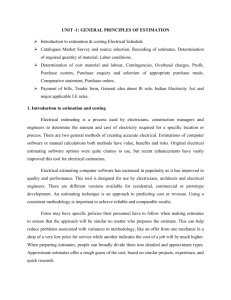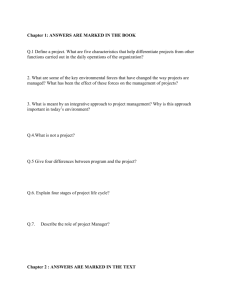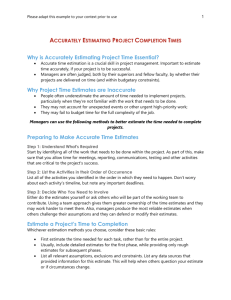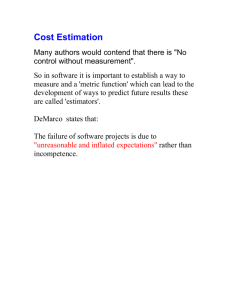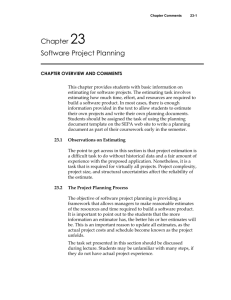Cost Estimation and Cost Management
advertisement
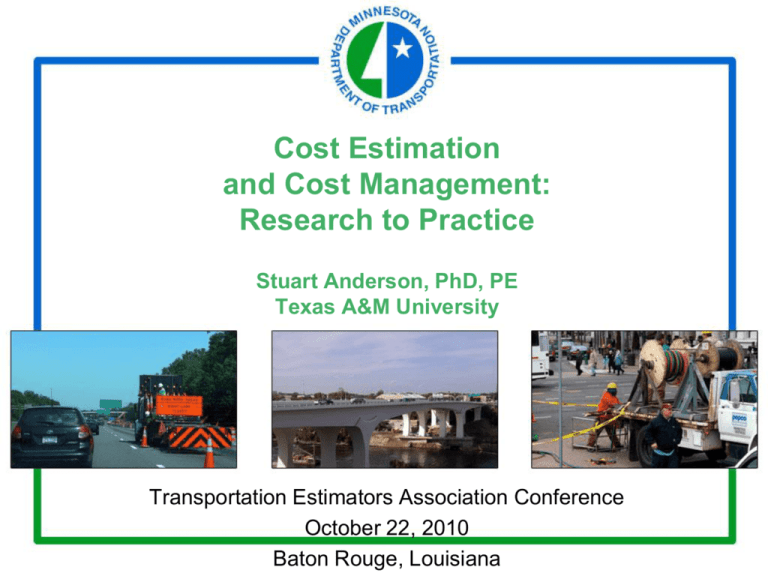
Cost Estimation and Cost Management: Research to Practice Stuart Anderson, PhD, PE Texas A&M University Transportation Estimators Association Conference October 22, 2010 Baton Rouge, Louisiana Outline • • • • • • • Challenge Approach Assessment Definition Development Details Issues and Gaps Cost Estimation and Cost Management Part of the Challenge: Estimating Under Fire Image003.jpg Cost Estimation and Cost Management “Theory to Practice” How? Cost Estimation and Cost Management • Framework – NCHRP Report 574 and Mn/DOT Scoping Process • Methodology with rigor • Industry involvement – Mn/DOT Professionals • Academics with right industry experience • Know user expectations Approach • Project – Cost Estimating Improvement and Organizational Integration • Four phases – Assessment – Definition – Development – Implementation Cost Estimation and Cost Management Assessment What is State-of-Practice? • Data Collection • Data Analysis • Results Cost Estimation and Cost Management What is State-of-Practice? Themes • Lack of systematic and structured approach • Lack of organizational strategies • Lack of management support • Focus on project delivery Cost Estimation and Cost Management What is State-of-Practice? Organization Issues • Estimators have multiple responsibilities • High workloads • Project Manager role and responsibility not clear • Functional areas drive project scope and scope changes • Lack of understanding of CE/CM processes Cost Estimation and Cost Management What is State-of-Practice? CE and CM Key Issues • Limited risk and contingency analysis with unclear definition of contingency • Lack of adequate documentation of estimate basis and estimate preparation • Lack of structured reviews • Lack of timely cost management Definition Champion and Vision Mn/DOT will manage and control costs through a department-wide priority on cost estimating and cost management, reliable and accurate estimates, statewide uniformity and consistency, improved communication and credibility with external stakeholders, and clear accountability. NCHRP REPORT 574 CE/CM STRATEGIES Mn/DOT leadership is committed to developing a standard process and supporting policies, integrating processes and policies across all functions, and making the necessary organizational adjustments to fulfill the vision. Mn/DOT STATEWIDE TRANSPORTATION PLAN Mn/DOT POLICY 9 INVESTMENT STRATEGIES Mn/DOT COST ESTIMATION PROCESS IMPROVEMENT AND ORGANIZATIONAL INTEGRATION VISION Mn/DOT CE/CM POLICIES Mn/DOT CE/CM PROCESS MODEL Mn/DOT CE/CM TECHNICAL REFERENCE MANUAL 11 NCHRP REPORT 574 GUIDING PRINCIPLES Development CE and CM Processes • • • • • Process focus Structured modeling technique Interactive workshops Tools Guidebook Cost Estimation and Cost Management Structured Modeling Technique Used IDEF0 » Integration DEFinition for Function Modeling (IDEF0) » Modeling Technique based on combined graphics and text that are presented in an organized and systematic way to gain understanding, provide logic for potential changes or support systems level design and integration activities » IDEF0 Model consists of a hierarchical series of diagrams, text, and glossary cross-referenced to each other » IDEF0 is being used for documentation, understanding, design, analysis, planning, and Integration » Based on structured analysis basic principle “To divide is to conquer, providing that it is clear how the divided pieces are structured together to constitute the whole” IDEF0 Syntax »Boxes »Arrows »Diagrams »Types of IDEF0 Diagrams »Diagram Features IDEF0 Boxes » Box provided a description of what happens in a designated function Perform Cost Estimation 1 » Function name is a verb or a verb phrase » Box number is shown insider lower right corner IDEF0 Arrows » One or more line segments with a terminal arrowhead at one end Straight Curved Forking » Arrows segments may be straight, curved or branching configurations » Arrows do not represent flow or sequence, they convey data or objects related to functions to be performed Joining » Bend arrows shall only have 90 degree arcs IDEF0 Arrow Positions and Roles Estimating Procedures/ Controls Policies Project Scope Inputs Historical Data Prepare Function Base Estimate 1 Outputs Base Estimate Estimators/ Mechanisms Estimating Spreadsheet Function - An activity or transformation identified by a verb phrase that describes what must be accomplished Inputs Controls Mechanisms Outputs - The data or objects that are transformed by the function into output - Conditions required to produce correct output (often called a constraint) - The means used to perform a function - The data or object produced by the function Interactive Workshops • Introduction of Technique • Variety of Mn/DOT/FHWA Professionals • Modeled CE and CM Process for four Mn/DOT Project Development Phase • Modeled “As Is” first then “Would Be” processes • Formalized model using IDEF0 • Reviewed All Models Cost Estimation and Cost Management Process Modeler Working Groups Facilitator Cost Estimation and Cost Management Notes Whiteboard with different colors CE and CM Tools • Basis – NCHRP Report 574 Tool Appendix • Survey tool usefulness • Workshop • Which tools • Tools and CE/CM process Cost Estimation and Cost Management Cost Estimation and Cost Management Cost Estimation and Cost Management Development How to Convert Process Models to Technical Reference Manual? Challenge! Cost Estimation and Cost Management TRM Challenges • • • • • Who is primary user? How present overall content? How to present detailed “how to” steps? What tools are used with which steps? What is layout, format, and structure? Cost Estimation and Cost Management Technical Reference Manual CONTENTS •Introduction •Essentials •Practice •Appendix Introduction • CE and CM Vision • Technical Reference Manual Layout Mn/DOT STATEWIDE TRANSPORTATION PLAN Mn/DOT POLICY 9 INVESTMENT STRATEGIES NCHRP REPORT 574 CE/CM STRATEGIES Mn/DOT COST ESTIMATION PROCESS IMPROVEMENT AND ORGANIZATIONAL INTEGRATION VISION Mn/DOT CE/CM POLICIES Mn/DOT CE/CM PROCESS MODEL Cost Estimation and Cost Management Mn/DOT CE/CM TECHNICAL REFERENCE MANUAL NCHRP REPORT 574 GUIDING PRINCIPLES Essentials • Project Development Process and CE/CM Process Integration • CE and CM Policies • CE and CM Process Overview Cost Estimation and Cost Management Project Delivery Process Phases Planning Scoping Design Letting Construction Time Project Development Process Major Activities Identify Needs (Huge List) Assign Project Manager STIP Amendments Scoping Worksheets Select Candidate Projects (Long List) Design Project Scoping Report Select Projects to Scope (Short List) Scope Approval LETTING Project Development Process Plans and Programs 20 Year Plan HIP (10 Year Plan) STIP Construction -20 -10 -4 Time (years) 0 10 Project Development Process Timeline by Project Type Years from Letting 10+ 9 8 7 6 5 4 3 2 0 LETTING Major Const. Reconstruction Bridge Safety Preservation Setaside Projects (e.g. BARC) 1 Project Planning Scoping Programming Design Planning Phase and Cost Estimating Project Planning ID Needs Compiled List of Needs (“Needs” List) 1.2 1.1 Assign PM Define Project Concept 1. Assume Fix 2. Rough Cost Estimate 1.3 Fiscal / Other Constraints 1.4 Needs Identification Stop Draft Project Planning Report 1.10 Continue Stop Compiled List of Projects (“Long” List) 1.5 Define Purpose 1.6 Identify Alternatives 1.7 Develop Cost Estimate Range Fiscal / Other Constraints 1.9 1.8 Candidate Projects Compiled List (“Short” List) 1.11 Create Project in PPMS, obtain SP# 1.12 Selected Projects Continue Project Planning Report 1.13 Y e s Letting Planned and >5 Years Out 1.14 No HIP 1.15 2.1 Scoping Phase and Cost Estimating Project Scoping HIP 1.15 Develop Alternatives (See HPDP) 2.2 Assign PM 2.1 Develop Preferred Alternatives 2.3 Alternative Selection Issues + Cost compiled by topic on Draft Scoping Report 2.5 Scoping Worksheets 2.4 Issue Resolution and Agreement on Scope 2.6 No Prepare Baseline Cost Estimate 2.7 Refine Project Schedule 2.8 Finalize Project Scoping Report 2.9 Approval of Final Scoping Report 2.1 Yes Detailed Scoping Compile List of Approved Scoped Project 3.1 Project Development (TRM Design Phase) STIP 3.4 Letting Project Change Process Scope, Cost, Time Change 4.1 No Yes Design Phase Yes Change Process Purpose & Need Change 4.2 No Change Request Form 4.3 ID Needs 1.1 No- Project needs Rescoping Program Evaluation Form 4.4 Change Approved 4.5 Yes- Approved or No- Scope Remains Unchanged CE and CM Policies • • • • • Project Cost Estimation Policy Uncertainty, Risk and Contingency Policy Communications Policy Project Cost Management Policy Program Management Policy Total Project Cost Components TOTAL PROJECT COST ESTIMATE RAW TOTAL DIVISION GROUP CATEGORY ELEMENT ITEM Total Before Inflation Engineering, Construction and Right-of-Way Engineering; Internal; Primary Construction; Letting; and so on. Project Development; State Share of Letting; Utilities; Railroads; and so on Related Work (e.g. Excavation; Paving; Bridges; etc) Specific Work with Unique Number (e.g. 2105607/00021: Excavation-Common 2105607/00025: Excavation-Subgrade) Gated Process Planning Phase HIP (Program) Scoping Phase STIP (Program) Design Phase Letting Phase PREPARE DESIGN APPROVED FINAL DESIGN PS&E Post-Letting PERIODIC HIP PROJECT COST UPDATES PREPARE PLANNING REPORT APPROVED PLANNING REPORT G1 ENTER AND G2B CONTINUE IN HIP G2A G4 PREPARE SCOPING REPORT ANNUAL STIP PROJECT COST AMENDMENT(S) G6 SOLICIT/ APPROVE BID PRICE G7 Gn GATES G1: To Enter HIP G2: To Proceed to Scoping G3: To Enter STIP G4: To Remain in STIP/ Proceed to Design G5: To Proceed to Letting G6: To Solicit/ Approve Bid Price G7: To Proceed to Construction APPROVED SCOPING REPORT G3 ENTER STIP APPROVED DISTRICT DESIGN SUBMITTAL LETTER G5 LETTING PHASE CONSTRUCTION PHASE Estimate Type Cost Estimating and Cost Estimating Management Purpose Transportation Need Development Phases Needs / Deficiencies Planning Definition (Concepts & Complexities) Conceptual Estimate Cost Estimating Total Planning Estimate Package Estimate Potential Funds Needed and Prioritize Needs for Long Range Cost Estimate (Prioritization Loop) Plans Cost Estimating Management Cost Estimating and Cost Management Process Overview Scoping HIP Design Estimating Cost Estimating Total Project Cost Estimate Package Estimate Baseline Cost for Projects and Program Projects Cost Estimating Management Approved Baseline Total Project Cost Estimate Package STIP Project Definition (% Design Complete & Project Complexity) Design Design Estimating Cost Estimating Updated Total Project Cost Estimate Package Manage Project Budget Design Development/ Site Conditions Cost Estimating Management Compare with Budget Approved Updated Estimates with Changes/ Scope Amendments Project Definition (Final Plans/ Specs & Complexities) Letting Cost Estimating PS & E Estimating Estimated Construction Cost to Obligate Funds and Compare with Bid Engineers’ Estimate Advertise & Bid Bid Data Cost Estimating Management Award Recommendation AWARD CONSTRUCTION Project Delivery Project Definition (Schematics / Alternatives Project Complexity) Long Range Plan Project Development Approved Planning Estimate Package Cost Estimating and Cost Management Process Framework Perform Cost Estimation (CE) & Cost Management (CM) A0 Perform CE & CM during Planning A1 Perform CE & CM during Scoping A2 Determine Estimate Basis A11 Determine Estimate Basis A21 Prepare Base Estimate A12 Prepare Base Estimate A22 Determine Risk & Set Contingency A13 Determine Risk & Set Contingency A23 Review & Approve Estimate A14 Review & Approve Estimate A24 Determine Estimate Communication Approach A15 Determine Estimate Communication Approach A25 Perform CE & CM during Design A3 Perform CE & CM during Letting Phase A4 Update Cost Estimate for CM A31 Determine Estimate Basis A41 Prepare Base Estimate A42 Assess Potential Changes for CM A32 Determine Risk & Set Contingency A43 Review & Approve Estimate A44 Determine Estimate Communication Approach A45 Practice • Overview of Cost Estimation and Risk Methodologies • Planning, Scoping, Letting • Design Cost Estimation and Cost Management Design CE and CM CM Through Estimate Updates Update Cost Estimates for CM A31 Update Estimate Basis A311 Update Base Estimates A312 Update Risk & Contingency A313 Review Risk Information A3131 Review Design Information A3111 Select Appropriate Approach A3121 Review Site Characteristics A3112 Quantify Estimate Elements or Line Items A3122 Update Risk Identification A3132 Develop Estimate Data A3123 Update Estimate Contingency A3133 Identify Changes A3113 Determine if Clarification Needed A3114 Document Updated Estimate Basis A3115 Calculate Cost Estimate A3124 Document Estimate Assumptions A3125 Prepare Estimate Package A3126 Document Risk & Contingency A3134 Revise Total Project Cost Estimate A3135 Review & Approve Updated Estimates A314 Determine Estimate Communication Approach A315 Reconcile with Baseline A3141 Communicate Estimate Basis A3151 Determine Review Level A3142 Communicate Estimate A3152 Review Estimate Assumptions A3143 Communicate Uncertainty & Assumptions A3153 Verify Completeness & Data A3144 Prepare Estimate Package A3145 Approve Updated Estimate A3146 Prepare Change Request A3147 Prepare Communication Package A3154 Cost Estimation and Cost Management Appendix • Glossary of Terms • Cost Estimating and Cost Management Tools • Tips for Estimating Cost Estimation and Cost Management Tool Structure • Selected smaller set of tools from NCHRP Report 574 • Used same structure and layout • Added “How To” instructions • Used Mn/DOT Examples when available Cost Estimation and Cost Management D4.1 Project Estimate File Tool Appendix – General Description Estimates are usually created by the collaborative effort of many individuals and to be able to follow the assumptions upon which the estimate is based, and preserve the information for future efforts there should be a structured system for accumulating all estimates and their supporting documentation. Estimators are required to prepare and maintain a master reference file that contains critical scope, policy, and supporting information (assumptions, methods, and procedures), which is used to prepare the project estimate. This master file is maintained as a permanent reference file. P4.1 Project Estimate File What is it? – Master reference file containing critical scope and estimate information. Why? – Good documentation supports cost estimate credibility, enables reviewers to effectively assess estimate quality, and aids in the analysis of changes. What does it do? – Provides corporate memory and historical database for cataloging the basic rationale behind the original cost estimate and reasons for subsequent cost revisions. When – Prepared and maintained from the initial estimate to project close out. Examples – Typical outline Tips – Need certain level of detail to track changes Resources – Tool Appendix 47 D4.1 Project Estimate File How to Use It • • • • • Set up notebook using tool outline sections Populate notebook with project definition basis Populate with cost estimate information Populate with risk and contingency information Include reconciliation documentation when comparing to previous estimates • Identify key information for a Cost Estimate Summary D4.1 Project Estimate File D4.1 PROJECT ESTIMATE FILE TYPICAL OUTLINE EXCUTIVE SUMMARY Total Project Cost Estimate Summary One Page (Category Level with some Elements of total project cost) Key Project Requirements Key Estimate Assumptions Major Risks TOTAL PROJECT COST ESTIMATE DETAILS (changes with project development phase) Estimate Basis Project Description (narrative description of project requirements) Drawings (schematic, preliminary, final) Specifications Cost Estimate Cost Estimate Summary (categories and some elements) Cost Estimate Details (categories, elements and line items) General Cost Basis for Estimate (impacts all cost in estimate) Assumptions (as required for different category, element, or item estimate) Backup Calculations (for different category, element, or item estimate) Review notes, reconciliation documents, and recommended changes Risk Analysis - Risks (red flag items, risk register, etc) and Contingency (contingency basis and calculation) Notes: Tips and Watch Outs Planning Tips Although the project has not been fully defined, do your best to determine the full scope of the project before putting an estimate together. Try to come up with as comprehensive a list as you can, time permitting, of all of the elements that will be required in the project. Visit the site in person. Become familiar with not only the roadway and operational issues, but other site conditions as well. Utilities, bridges, sidewalks, buildings, cut and fill slopes, waterways, etc. will have an effect on project costs and the more familiar the estimator is with a given site the more likely these items will be considered. Cost Estimation and Cost Management Tips and Watch Outs Planning Watch Outs Planning estimates may sit on the shelf for many years before moving to scoping, design, and construction. Planning estimates should be reviewed and refreshed regularly to reflect potential changes in scope, unit prices, regulatory requirements, etc. This is also a good time to review the assumptions and revise as necessary. The estimating tools available can provide very precise numbers. The total cost is usually displayed to the nearest dollar, sometimes even to the penny with many tools. When these estimates are shared within the organization, or even outside the organization, the impression given is that the estimate is very accurate. Planning estimates should always be rounded up to the nearest thousand, ten thousand, or hundred thousand dollars depending on the relative magnitude of the cost. Cost Estimation and Cost Management Implementation Training • Cost Estimating Course • Cost Management Course Help! Cost Estimation and Cost Management Gaps and Other Issues What Else? • Audience – missing support for senior estimators • Layout, format, and structure – too cumbersome • Total project cost – how to estimate other elements of total project cost • Tool integration – fit with processes • Tool development – few Mn/DOT examples Cost Estimation and Cost Management TRM Website Address: http://dotapp7.dot.state.mn.us/edms/download?docId=670233

